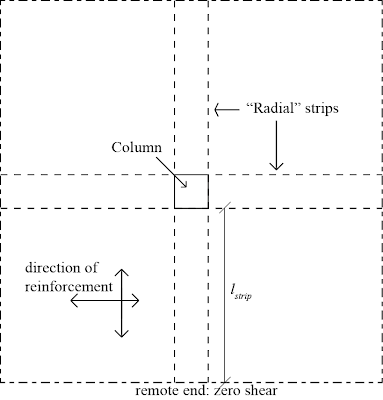Project #tweetprop: the Modified Bond Model
The second proposition of my dissertation is the following:
By combining two-way quadrants and one-way strips, the Modified Bond Model bridges the gap between the one-way and two-way shear approaches.
or in Dutch (as the propositions are in English and Dutch:
Door in twee richtingen dragende kwadranten te combineren met stroken die in één richting dragen overbrugt het Modified Bond Model de kloof tussen de methodes voor pons en dwarskracht
Admittedly, this proposition is more difficult to explain without dwelling upon all the technical details – but bear with me for this one, the lighter propositions will be up soon.
The Modified Bond Model is the theoretical model that I propose to determine the capacity of a slab subjected to a concentrated load close to the support. As its name suggests, it is a modification of the Bond Model by Alexander and Simmonds [1], which was developed for concentric punching shear in slabs.
In other words: while the Bond Model studies a single load (or column) on an infinitely large slab, the Modified Bond Model looks at the practical case of a slab with a certain geometry subjected to a concentrated load.
The Bond Model divides the slab into 4 strips, that branch out from the load, and 4 quadrants. All loading is carried from the slab to the column, via the strips. As such, the governing cross-section is the interface between the quadrants and strips. The capacity is defined as the sum of the capacities of the 4 radial strips.
The Modified Bond Model goes one step further. As we found in the experiments that the geometry is decisive for the shear capacity of slabs subjected to concentrated loads close to supports, we defined reduction factors that reduce the capacity of the strips. One of the advantages of the Modified Bond Model is that it is easy to calculate (you can do it by hand), and that it can incorporate a variety of different geometries.
So these ideas explain you the Modified Bond Model. But how does it bridge the gap between one-way and two-way shear approaches, and what is so cool about that?
Let me start by saying that our experiments, and thus the case of a slab subjected to a concentrated load close to the support, is a type of shear failure that is in-between the typical beam shear failure and punching shear failure modes. We see inclined cracks at the bottom face, but also punching damage and shear cracks at the side faces. The codes deal with these two failure modes in a very separated way, while in reality there is a transition zone. You can understand that it is thus important to find a method that describes this transition zone.
The Modified Bond Model does exactly that. The strips work in arching action, and the quadrants work in beam shear. The strips carry load in one direction (cfr. one-way shear) and the quadrants carry load in both directions (cfr. punching shear), off to the two strips that border each quadrant.
As such, the Modified Bond Model uses elements of one-way and two-way shear approaches, and helps us to describe the transition zone between pure beam shear behavior and punching shear behavior.
[1] Alexander, S. D. B. and Simmonds, S. H., 1992, “Bond Model for Concentric Punching Shear,” ACI Structural Journal, V. 89, No. 3, pp. 325-334.

